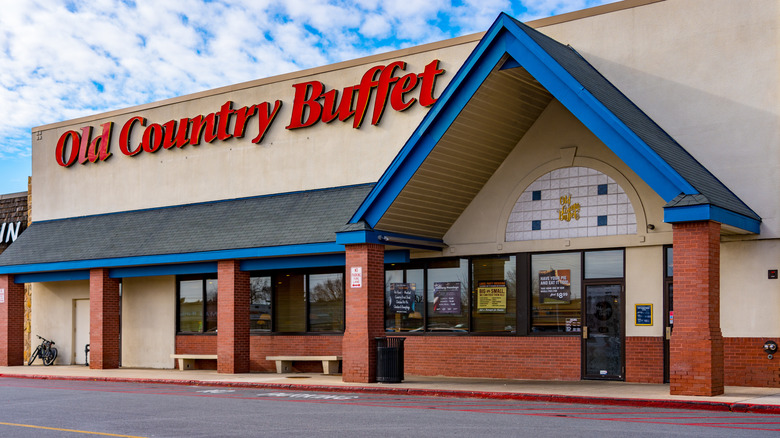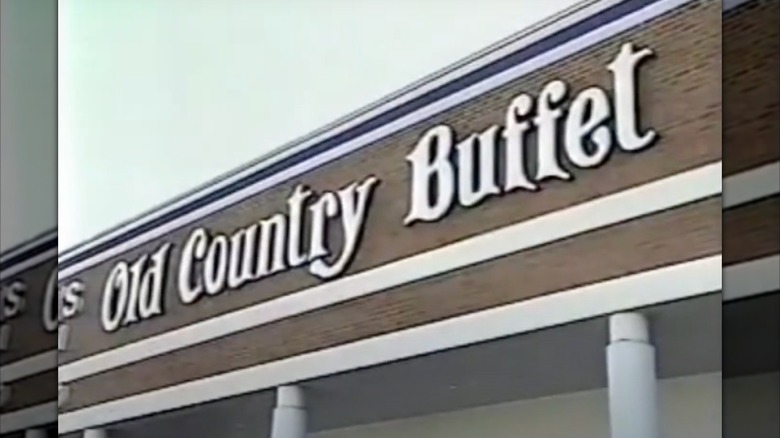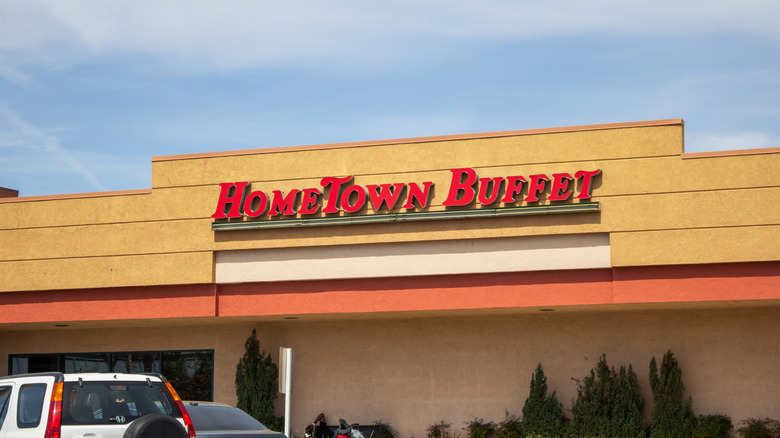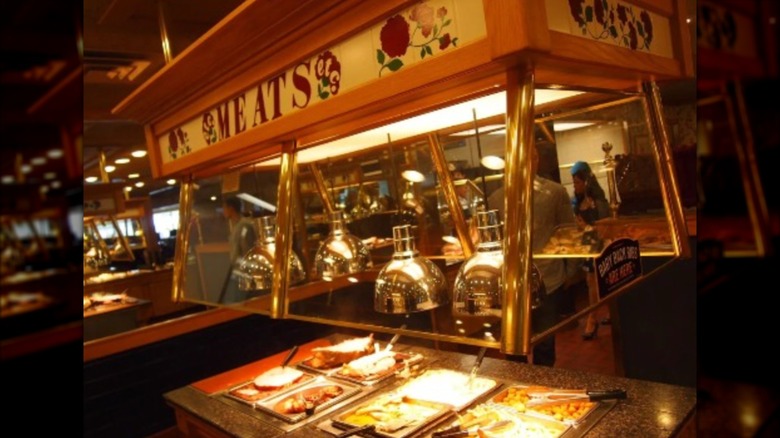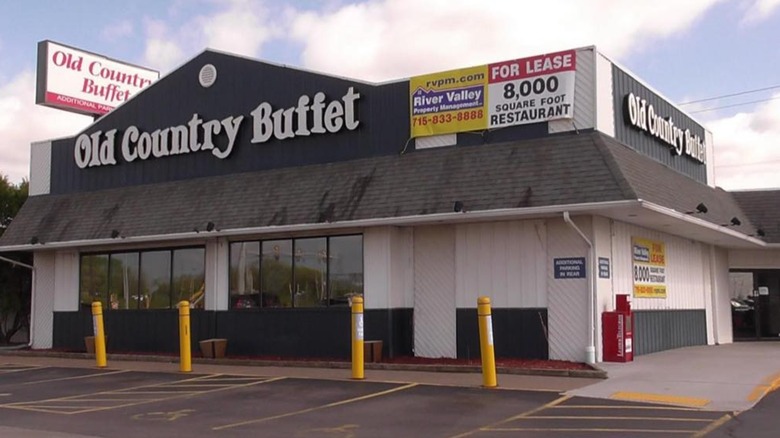The Essential Recap Of Old Country Buffet And Its Collapse
Few dining styles can tell us more about where the U.S. stands than the buffet. The appeal of all-you-can-eat formats seems to wax and wane depending on economic and cultural changes in tide, and buffet businesses can often face a rocky road as a result. Some of them, like Old Country Buffet, end up going out of business entirely. This buffet chain was once the leader of the pack when it came to offering copious amounts of food at an affordable price, and at one point it had roughly 350 locations dotted across the country. Just a couple of decades later, though, it was facing a string of bankruptcies and lawsuits, and when poor business practice met a lack of enthusiasm around buffets, it plunged into oblivion.
How exactly did everything go so wrong, though? At what point did Old Country Buffet lose its way, and why did this once-beloved chain start to look so old-fashioned in the eyes of its customers? It seems that the downfall of Old Country Buffet is a tale as old as time, of an American business that flew too close to the sun — and we're gonna tell you exactly how it went down.
Old Country Buffet was born in 1983
When Old Country Buffet came into being, it seemed to answer a lot of people's prayers. The origins of the buffet are pretty long, and it had been around since the 1940s in the United States. However, for a long time they were a Vegas-bound concept that didn't get far out of Sin City. The long tables piled high with food felt like the height of excess, and elsewhere in the country, they weren't as available. However, by the time the '80s rolled around, people were ready to live it large: The buffet was king, and everyone wanted a piece of it.
Enter Buffets Inc., the parent company of Old Country Buffet which was founded in 1983 with the chain as its flagship outing. Created by Roe Hatlen and Dennis Scott, it was launched in the Midwest with the triple intentions of offering food that was affordable, high-quality, and with a homestyle feel. Within two years, Old Country Buffet had seven locations, growth which by today's standards is frankly phenomenal. Buffets Inc., meanwhile, went public. The rise of this chain had just started, and things were about to get even bigger.
The buffet chain's appeal lay in its homely food at an affordable price
If you compared Old Country Buffet to even the most mild-mannered buffet restaurant in Vegas, it would hardly match up in terms of pizzazz and excitement. However, that was also its USP. This restaurant chain didn't try to offer every menu item under the sun or beat you over the head with extravagance, but instead it tried to serve up a "home cooking" style in buffet form. The idea was that instead of spending all day in the kitchen making your favorites, you could hop in the car and enjoy them instantly.
Old Country Buffet's commercials from its early days certainly reflect this feel. "Remember when mom's home cooking was so special no-one could match it?", said one voiceover in a 1990 commercial seen on YouTube while a woman takes home-cooked food out of the oven. "Old Country Buffet brings that magic back." The commercial then pans over endless rows of salads, stuffing, mashed potatoes, and sliced ham. Another commercial highlighted its appeal to kids, and featured smiling children serving themselves corn on the cob and green beans (if only it was that easy to get your kids to eat their veggies, huh?). Best of all was the price: In 1990, dinner would cost you just $6.19, while lunch was $4.69.
Old Country Buffet's power grew in 1996 due to a merger
Throughout the 1990s, Old Country Buffet's fortunes continued to rise: Just a decade before, it was barely starting out, and by 1996 it had a grand total of 252 restaurants. Talk about a speedy expansion, huh? Meanwhile, its operator Buffets Inc. was making some big moves. That same year, it agreed to a merger with Hometown Buffet Inc., a rival buffet chain and business. By doing this it created an absolutely massive restaurant chain with combined sales of over $660 million, and a grand total of 332 locations in its portfolio.
If this move shocked the restaurant world, it really shouldn't have. Both Buffets Inc. and Hometown Buffet Inc. were founded by the same person, Dennis Scott. While we're not privy to exactly what went on behind the scenes, we'd imagine that the fact that he had helped to sculpt both of these businesses was largely why folks thought they could operate together. Interestingly, though, on the day that they merged, shares in both Hometown Buffet Inc. and Buffets Inc. dipped considerably. Maybe folks were realizing that there was some trouble lying ahead.
As the 2000s rolled around, Old Country Buffet's fanbase remained strong
By the 2000s, the heyday of the buffet was starting to end, but anyone looking at Old Country Buffet would have a hard time recognizing that. The massive closures of restaurants were still a few years away, and it seemed like it was still riding high. Old Country Buffet was enjoying a stream of positive press as late as 2007, and the quality of its food remained great. Some stores were racking up absolutely massive sales, too. One restaurant in Meadow Glen Mall reported hundreds of customers each Monday for the lunch rush (clearly people knew that lunchtime is the best time to go to a buffet), and was getting through 600 pounds of fish per week. Even to this day, people remember the noughties as a golden era in Old Country Buffet's history, trading stories online about its food and its warm atmosphere.
Old Country Buffet's crowning moment during this period was a merger with Ryan's Restaurant Group. Announced in November 2006, this move saw Buffets Inc. grow to even greater proportions. This should have been the moment that the company began truly dominating the restaurant space, serving up homestyle classics like chicken-fried steak to the entire world. Unfortunately, though, it was the moment that things all started to go downhill.
2008 was a difficult year for Old Country Buffet
As the mid-noughties hit, things were looking reasonably good for Old Country Buffet — but disaster was just around the corner. The year of the global financial crisis also brought about a crisis for the buffet chain, although it had started to find itself in a difficult spot a few years before that. Buffet Inc.'s merger with Ryan's Restaurant Group in 2006 was framed as a win for the company, but it also lumbered it with a massive debt to pay of well over $800 million. This might not be a problem if it was also able to keep customers coming through the doors, but it was also experiencing falling sales as people went elsewhere.
Things got to a crisis point in 2008, when Buffets Inc. had to file for Chapter 11 bankruptcy. Its debts had increased even more by that point, and it had begun to close restaurants in a bid to stave off disaster. During 2008, though, it had to shutter a massive 78 locations, a huge chunk of its portfolio. High-traffic areas like Central New York were left without any Old Country Buffets to choose from, leaving the company with a lack of a footprint in important markets.
A further bankruptcy claim in 2012 hit the brand hard
Buffets Inc.'s first bankruptcy claim in 2008 was undoubtedly a tough moment for the company and for its brands, but the following year it managed to somewhat bounce back. As the world emerged blinking from the financial crisis, Buffets Inc. managed to secure the backing of several lenders, and by April 2009 it had hefty monetary commitments which were intended to help revive Old Country Buffet. Unfortunately, though, over the next few years it continued to struggle with a terrible debt burden — and although it had managed to pay off a lot of what it was owed, by 2012 it still owed around $240 million.
As a result, it had to once again concede defeat. In 2012 it claimed bankruptcy again, making it the second time the company had done so in four years. Buffets Inc. agreed to a deal with its lenders which saw them taking a controlling equity stake in the business, and framed it as a restructure. However, this move also came with a massive closure of restaurants, and Buffets Inc. closed 81 units across the board, including Old Country Buffet locations. The future was looking dark for this brand.
As Old Country Buffet declined, tastes were changing
Arguably the biggest key factor in Old Country Buffet's downfall was the debt that its parent company was accruing, but how did it get into such a difficult spot in the first place? Well, partly because the buffet concept itself was starting to lose steam. The noughties and 2010s saw a host of new dining styles come into fashion, with fast casual dining and farm-to-table concepts becoming trendy and appealing. Meanwhile, buffets started to feel over-indulgent and didn't quite fit in with a more health-conscious America. The secret of the all-you-can-eat buffets was out: They were in trouble.
When you throw in the fact that buffets themselves are often hard to keep profitable, operating with super-thin margins, a cultural shift can spell the end for them. Old Country Buffet reckoned with all of this throughout the 2010s as it faced further decline. Buffets Inc., which was renamed to Ovation Brands, was acquired by Food Management Partners. While this was once again framed as a great move for everyone, reported layoffs caused tension and worry in the restaurant world. It was only a matter of time before there was more drama around the corner.
A lawsuit in 2014 led to another bankruptcy
If you thought that Old Country Buffet would have achieved any respite in the mid-2010s, you're sadly mistaken. By this point, the buffet chain was well and truly on its last legs, and it couldn't afford any more setbacks. Unfortunately, one such disruption came in the form of a huge lawsuit in 2014. The events of the lawsuit came a few years before, when a Nebraska couple were dining in an Old Country Buffet in 2010. One of the pair, Chris Gage, contracted Salmonella at the restaurant, and he experienced an extreme response to the illness which left him with permanent damage to his health.
Several years later, Gage and his wife successfully sued Ovation Brands for $11.37 million. Notably, Ovation Brands chose not to have any representatives at the lawsuit hearing and didn't defend itself after being served notice, a move that can have serious consequences. The lawsuit was cited as one of the factors in Ovation Brands' 2016 claim for bankruptcy, with poor revenue also named as a contributing issue. This was the third time that the company had filed for bankruptcy in a decade, and it had a crushing impact on its business. In 2017, Old Country Buffet sales had dropped by 37.5%.
By the time COVID-19 came around, Old Country Buffet was in its final days
There was once a time when you could find an Old Country Buffet in most cities across the country. By the end of the 2010s, its restaurants were more like rare birds. As 2019 turned into 2020, Old Country Buffet operated only 90 remaining restaurants ... And then, COVID-19 hit.
You don't need us to tell you how hard this moment was on restaurants, but for business models like Old Country Buffet's, it was especially difficult. People could no longer head to physical locations to eat, which buffets relied on, and when you combine that with crowded dining rooms and shared serving utensils it was a recipe for disaster. Other buffets saw their sales plummet, and Old Country Buffet was no different. Throughout 2020, the company started seeing restaurants close permanently as a result of disruption caused by COVID, and it wasn't long before they were shutting down in droves.
In 2021, one final bankruptcy finished Old Country Buffet for good
In a post-lockdown landscape, the writing was on the wall for Old Country Buffet, and the first few months of 2021 saw everything finally end for this venerable chain. Coming out of 2020, all of its stores — as well as the vast majority of the restaurants owned by Buffets LLC, the owner of Old Country Buffet — were shut. However, although it didn't look likely that they were coming back, there was still a glimmer of hope.
That hope was dashed, though, when Buffets LLC declared bankruptcy in April 2021. In a surprise to no-one, it stated that its operations had been severely disrupted through COVID. This bankruptcy made it the fourth one that Old Country Buffet's owners had endured, and it proved to be the final straw, with a further blow dealt later in the year when it was accused of misusing Paycheck Protection Program funds by creditors. The start of 2021 saw new company VitaNova Brands assume responsibility for management of Buffets LLC and Old Country Buffet, and in a cheery statement it said that it was looking forward to a brighter future. However, that future didn't include Old Country Buffet. The restaurant chain was long gone, never to return.

